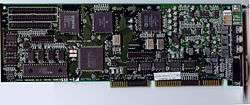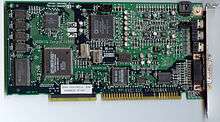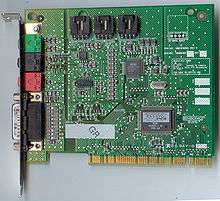Ensoniq
 | |
| Corporation | |
| Industry | Musical Instruments and Technology |
| Fate | acquired by Creative Technology (January 1998) |
| Founded | 1982 |
| Headquarters | Malvern, Pennsylvania |
Key people | Bruce Crockett, Al Charpentier, and Bob Yannes (founders) |
| Website |
www |
Ensoniq Corp. was an American electronics manufacturer, best known throughout the mid-1980s and 1990s for its musical instruments, principally samplers and synthesizers.
Company history
In spring 1983 former MOS Technology engineers Robert "Bob" Yannes, Bruce Crockett, Charles Winterble, David Ziembicki, and Al Charpentier formed Peripheral Visions. The team had designed the Commodore 64, and hoped to build another computer. To raise funds, Peripheral Visions agreed to build a computer keyboard for the Atari 2600, but the video game crash of 1983 canceled the project and Commodore sued the new company, claiming that it owned the keyboard project. Renaming itself as Ensoniq, the new company instead designed a music synthesizer.[1]
In January 1998, ENSONIQ Corp. was acquired by Creative Technology Ltd. for $77 million, and merged with E-mu Systems to form the E-Mu/Ensoniq division. The fusion with E-mu sealed Ensoniq's fate. After releasing an entry-level E-mu MK6/PK6 and Ensoniq Halo keyboards in 2002 – essentially keyboard versions of the Proteus 2500 module – the E-Mu/Ensoniq division was dissolved and support for legacy products was discontinued soon afterward.
Musical instruments and digital systems

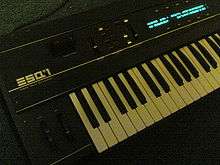
Ensoniq entered the instrument market with the Mirage sampling keyboard in 1985. At the price of USD$1695 it cost significantly less than previous samplers such as the Fairlight CMI and the E-MU Emulator. Starting with the ESQ-1, they began producing sample-based synthesizers. Following the success of these products, Ensoniq established a subsidiary in Japan in 1987.
Ensoniq products were highly professional. Strong selling points were ease-of-use and their characteristic "fat", rich sound (generally thought of as being an "American" quality, as opposed to the "Japanese" sound which was more "digital" and somewhat "cold"). After the Mirage, all Ensoniq instruments featured integrated sequencers (even their late '80s and early '90s samplers) providing an all-in-one "digital studio production concept" instrument. These were often called "Music Workstations". Starting with the VFX synthesizer, high-quality effects units were included, in addition most synthesizer and all sampler models featured disk drives and/or RAM cards for storage. The manuals and tutorial documents were clearly written and highly musician-oriented, allowing the users to quickly get satisfactory results from their machines. In 1988, the company enlisted the Dixie Dregs in a limited edition promotional CD Off the Record which featured the band using the EPS sampler and SQ-80 cross wave synthesizer.
The company had much success with the SQ product line starting in the early 1990s. This was a lower-cost line that included the SQ-1 (61 keys), SQ-2 (76 keys) and SQ-R (rack-mounted, with no keys or sequencer). Later versions were produced with 32 sound-generating voices.
.jpg)
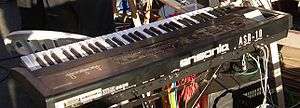
The company's heyday was in the early 1990s when the VFX synthesizers offered innovative performance and sequencing features (and terrific acoustic sounds), along with the ASR series of 16-bit samplers which also integrated synthesis, effects, and sequencer into a single-unit digital studio. The TS synthesizers followed the legacy of the VFX line, improving several aspects such as the polyphony, effects engine, sample-loading capabilities and even better synth and acoustic sounds. The DP series of effects rack-mount units offered parallel processing and reverb presets on a par with Lexicon's offerings, but at affordable prices.
Despite these strengths, early (1980s) Ensoniq instruments suffered from reliability and quality problems such as bad keyboards (Mirage DSK-8), under-developed power-supply units (early ESQ-1), or mechanical issues (EPS polypressure keyboard). Through the early and mid-1990s, much effort was focused on improving the reliability of the products. The company didn't manage to reinvent its workstation concept in order to survive the mid and late '90s, and no lower-budget versions of their keyboards were offered to replace the aging SQ line. Excellent synthesizers like the VFX or TS models lacked cheaper rack-mount counterparts. Finally, while the competition's products were continually evolving and newer technologies such as physical modeling were introduced, Ensoniq failed to follow the late '90s market orientation, often recycling old concepts on their new products. During this time, much of the engineering effort and company resources were focused on computer sound cards, which offered more profit for the company.
Timeline of major products
.jpg)

.jpg)
- 1985 – Ensoniq Mirage
- 1986 – Ensoniq ESQ-1
- 1986 – Ensoniq SDP-1 Sampled Digital Piano[2]
- 1988 – Ensoniq SQ-80
- 1988 – Ensoniq EPS
- 1989 – Ensoniq EPS-M[3]
- 1989 – Ensoniq VFX
- 1990 – Ensoniq SQ-1[4]
- 1990 – Ensoniq SQ-2
- 1990 – Ensoniq SQ-R, later Ensoniq SQ-R plus
- 1990 – Ensoniq EPS 16 Plus
- 1990 – Ensoniq SD-1
- 1992 – Ensoniq KS-32
- 1992 – Ensoniq ASR-10
- 1993 – Ensoniq TS 10
- 1993 – Ensoniq DP/4[5]
- 1995 – Ensoniq DP/2[6]
- 1995 – Ensoniq DP/4+
- 1996 – Ensoniq MR61
- 1996 – Ensoniq KT-76 Ensoniq KT-88
- 1997 – Ensoniq ASR X[7]
- 1997 – Ensoniq E Prime

- 1998 – Ensoniq Fizmo
- 1998 – Ensoniq ZR-76
- 1998 – Ensoniq ASR X Pro
- 1998 – Ensoniq PARIS Digital Audio Workstation[8]
- 2002 – Ensoniq Halo (E-mu product using Ensoniq brand)
Sound cards and semiconductors
Ensoniq was known not only for their innovative musical instruments division, but also for their computer audio chips. In 1986, after making an agreement with Apple Computer, the same ES5503 DOC (Digital Oscillator Chip) utilized in the Mirage sampler (DSK-8, DSK-1, DMS-1), ESQ-1, ESQm and SQ80 synthesizers, and SDP1 piano module was incorporated into the Apple IIGS personal computer.
Later engines, featuring true 16-bit sample playback and internal digital filters, were ES5504 DOC-II (used in the EPS sampler) and ES5505 OTIS (used in the EPS16+ sampler and the VFX line of synthesizers featuring 21 voices). Finally, ES5506 OTTO drove all subsequent 32-voice machines (SD-1/32, TS10/12, ASR-10/88). The latest incarnation, ES5548 OTTO-48, was used in the final line of Ensoniq studio products (ASR-X, FIZMO, and MR).
Ensoniq also developed a versatile effects DSP, ES5510 ESP, that was used in the machines from the VFX on. OTTO-48 generation uses its greatly enhanced successor, ES5511 ESP V2. A combination of OTTO and ESP, ES5540 OTTOFX, was developed but not used commercially.
The Ensoniq ES5505 OTIS/OTISR2, ES5506 OTTO and ES5510 ESP (Ensoniq Signal Processor) were also used in various arcade games. They were all manufactured on the CMOS process. The OTTO was licensed to Advanced Gravis for use in the Gravis Ultrasound card. In 1994 production began on PC sound cards for home computers. The design of the video game console Atari Panther also included the OTIS chip, though the product never reached series production. A dedicated version of OTTO, ES5530/35 OPUS, was developed for AT-bus sound cards, featuring built-in joystick and CD-ROM interface.
Ensoniq's sound cards were highly popular, secured numerous OEM wins and enjoyed good compatibility throughout their lifetime, with virtually every newer DOS-era game supporting the Ensoniq Soundscape either directly or through General MIDI. In addition, Ensoniq devised an ISA software audio emulation solution for their new PCI sound cards that was compatible with most DOS games. It is speculated that this was an important factor in Creative Lab's acquisition of Ensoniq, because Creative/E-MU was struggling with legacy DOS compatibility at the time with their higher-performance PCI audio solutions. According to one source, because of the wide range of patents Ensoniq had involving the PCI bus support for the sound cards, and the fact that Ensoniq wanted E-MU's technologies, the buyout of Ensoniq became the best of both worlds.
Soundscape
- Ensoniq Soundscape S-2000 The original Soundscape was Ensoniq's first direct foray into the PC sound card market. It was a full-length ISA digital audio and 'wavetable' sample-based synthesis audio card, equipped with a 2 MB Ensoniq-built ROM-based patch set.
- Ensoniq SoundscapeDB The SSDB was a 'wavetable' daughterboard (sample-based synthesis daughterboard) upgrade for PCs with a sound card bearing a Wave Blaster-compatible connector. It was based upon the S-2000 chipset but was without the digital sound effects section or any DAC. The SSDB would use the host sound card for final output.
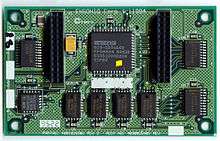
- Ensoniq Soundscape Elite The ELITE was Ensoniq's high-end ISA offering. It offered the highest MIDI quality of any PC sound card they ever made, including the newer AudioPCI. The Elite was based mostly around the S-2000, with some additional features that set it far apart from its progenitor.
- Ensoniq Soundscape OPUS This card was a Gateway 2000 OEM, and possibly was used by other OEMs, but was never sold to Ensoniq's customers directly. It was a Soundscape-like board, using the Ensoniq 5530/5535 OPUS multimedia sound chip, a chip that was only used on these OEM boards and essentially comprises an OTTO with back-then usual additional interfacing (Joystick, CD-ROM).
- Ensoniq Soundscape VIVO90 was Ensoniq's generational step forward from the Ensoniq Soundscape S-2000-based boards. It was first produced in 1996. VIVO90 had similar specifications to the older boards, but was built to cost less to manufacture.
AudioPCI
- Ensoniq AudioPCI The AudioPCI was designed to be a low-cost, yet feature-rich audio solution, which could be integrated on computer motherboards as a value-added option. It consisted of little more than a small, host CPU driven audio chip (one of the following: S5016, ES1370, ES1371) and a companion DAC. Despite its small size and low cost, AudioPCI still offers nearly all of the audio capabilities and functionality of the Soundscape ELITE card. The AudioPCI line utilized an NMI-based emulation TSR program Ensoniq developed to provide a reasonable level of legacy DOS compatibility without requiring any signals from the ISA bus, though the TSR could cause problems with games that relied on custom flavors of protected mode.
References
- ↑ Perry, Tekla S.; Wallich, Paul (March 1985). "Design case history: the Commodore 64" (PDF). IEEE Spectrum: 48–58. ISSN 0018-9235. Retrieved 2011-11-12.
- ↑ "Ensoniq Sampled Piano". Sound On Sound. September 1986. pp. 8–9. ISSN 0951-6816. OCLC 925234032.
- ↑ "Ensoniq EPS-M Sampler Module". Music Technology. May 1989. p. 14. ISSN 0957-6606. OCLC 483899345.
- ↑ "Ensoniq SQ1". Music Technology. October 1990. pp. 64–69. ISSN 0957-6606. OCLC 483899345.
- ↑ "Parallel Lines". Recording Musician. August 1992. pp. 32–36. ISSN 0966-484X. OCLC 264952514.
- ↑ "Ensoniq DP/2". Sound On Sound. December 1995. Archived from the original on 8 June 2015.
- ↑ "Ensoniq ASRX". Sound On Sound. September 1997. Archived from the original on 7 June 2015.
- ↑ "Ensoniq Paris II". Sound On Sound. January 1998. Archived from the original on 24 September 2015.
- Ensoniq Corp., Dixie Dregs, "Off the Record", ENS-1000, 1988.
- Case, Loyd. "In Search Of The Ultimate... Sound Card." Computer Gaming World Dec. 1994: 138-148.
- Ensoniq Corp. Soundscape S-2000 Manual, Ensoniq, 1994.
- "Ensoniq Corp. Web Site" by Ensoniq Corp., Multimedia Division Product Information and Support Pages, 1998, retrieved December 25, 2005
- "Ensoniq FAQ" by Ensoniq Corp., Multimedia Division Product Information and Support Pages, 1997, retrieved December 27, 2005
- Prince, Bobby. "In Search Of The Ultimate... Wavetable Daughtercard." Computer Gaming World Dec. 1994: 156-164.
- Weksler, Mike & McGee, Joe. "CGW Sound Card Survey." Computer Gaming World Oct. 1993: 76-84.
External links
| Wikimedia Commons has media related to Ensoniq. |
